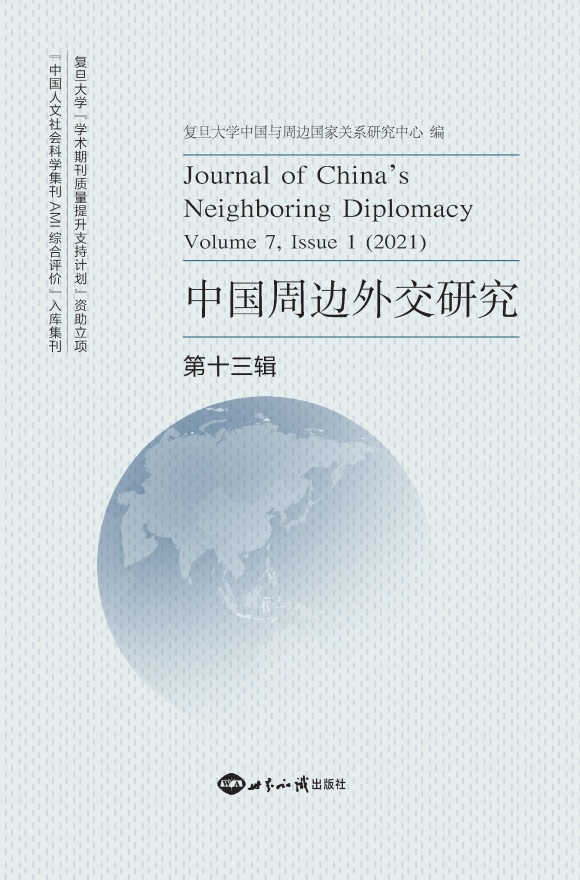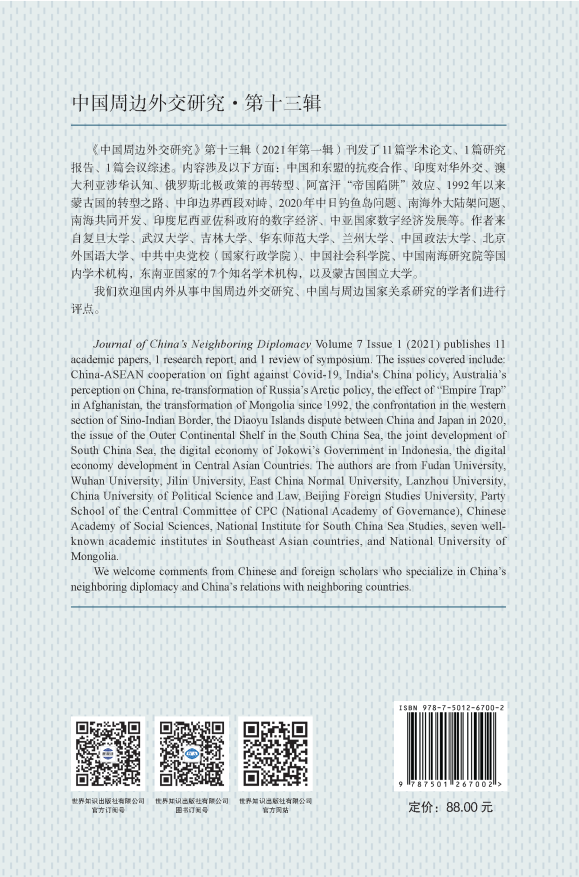|
|
The Title Page of Journal of China's Neighboring Diplomacy, Vol. 7, Issue 1 (2021) | The Back Cover of Journal of China's Neighboring Diplomacy, Vol. 7, Issue 1 (2021) |
Center for China’s Relations with Neighboring Countries of Fudan University (CCRNC Fudan), ed., Journal of China's Neighboring Diplomacy, Vol. 7, Issue 1, 2021.
Publisher: World Affairs Press (China)
Published in December 2023.
ISBN: 978-7-5012-6700-2
Contents
Preface of Volume 7 Issue 1 (2021)……QI Huaigao / 1
Covid-19 Pandemic and Neighboring Diplomacy
Research Report on ASEAN-China Cooperation in the Fight against Covid-19……/ 9
The New Trend of India’s China Policy since the COVID-19 Pandemic……YANG Lu / 46
Studies on Neighboring Countries
Re-Transformation of Russia’s Arctic Policy in the New Environment: Goals, Paths and Challenges……XU Bo and CHEN Liying / 65
Mongolia’s 30 Years Transition: The Political Reform and Evolution of Mongolian People’s Party……QI Zhiye and HUANG Tonglaga / 83
On the Effect of “Empire Trap” in Afghanistan…… DU Zheyuan / 114
Neighboring Countries’ Diplomacy towards China
Changes and Non-Changes in Australia’s Perception Involving China since the Global Financial Crisis in 2008……SUN Xihui and LIU Yutong / 137
China’s Boundary and Ocean Affairs
The Confrontation in the Western Section of the Sino-Indian Border and Its Impact on Bilateral Relations……GUAN Peifeng and WAN Jia / 163
The Characteristics and Causes of the Recurrence of the Diaoyu Islands Issue in 2020……BAO Xiaqin and SONG Ao / 181
A Preliminary Analysis on the Issue of the Outer Continental Shelf in the South China Sea……YANG Li / 197
Joint Development in the South China Sea: China’s Incentives and Policy Choices……QI Huaigao / 217
Studies on Digital Economy in Neighboring Countries
Study on the Development of Digital Economy under Jokowi’s Government……XIA Fangbo / 233
Digital Economy Development in Central Asian Countries and Their Cooperation with China……WANG Haiyan / 257
Review on Symposiums
Review on Academic Seminar Heralding the 116th Anniversary of Fudan University China and Southeast Asia in the Perspective of Neighborhood…… / 285
Appendix
Introduction on Center for China’s Relations with Neighboring Countries of Fudan University (CCRNC Fudan) ……/ 291
Notice Inviting Contributions to the Journal of China’s Neighboring Diplomacy……/ 293
Standards of Articles and Annotations of the Journal of China’s Neighboring Diplomacy……/ 295
Acknowledgements……/ 300
Research Report on ASEAN-China Cooperation in the Fight against Covid-19
Author Scholars of NACAI Member Institutes: Bruno Jetin, Ngeow Chow Bing, Nguyen Huy Hoang, Li Mingjiang, Joefe B. Santarita, ChawChaw Sein, Aye Ei Ei Aung Than, Yao Wen, Ali Abdullah Wibisono, and Yang Zi.
Official Citation: Scholars of NACAI Member Institutes, “Research Report on ASEAN-China Cooperation in the Fight against Covid-19,” Journal of China’s Neighboring Diplomacy, Vol. 7, Issue 1, 2021, pp. 9-45.
![]() 1 中国—东盟学术共同体成员机构学者_中国和东盟的抗疫合作研究报告.pdf
1 中国—东盟学术共同体成员机构学者_中国和东盟的抗疫合作研究报告.pdf
The New Trend of India’s China Policy since the COVID-19 Pandemic
YANG Lu
Abstract Since the COVID-19 pandemic, India’s China policy has undergone major adjustments. In the field of economy and trade, India initiated and deepened the process of decoupling with China. In the field of security, India implemented a confrontational border policy and planned military reforms. In the field of soft power, India competed with China in political ideology and vaccine aid. After nearly a year of practice, the competitive foreign policy of the Modi government in the field of economy and trade and soft power has failed to achieve the expected results, and the prospect of its policy in the military field is also not optimistic. Facing the new trend of India’s China policy, China should first make policy preparations for a long-term low ebb bilateral relationship. Secondly, draw a clear bottom-line to keep the Sino-Indian relations within a controllable range. Thirdly, persist in mutual trust building and focus on the long-term development of the bilateral relations.
Keywords COVID-19 Pandemic; Economic Decoupling; Military Confrontation; Soft Power Competition
Author Yang Lu, Lecturer of Institute for International Strategic Studies, Party School of the Central Committee of CPC (National Academy of Governance).
Official Citation: YANG Lu, “The New Trend of India’s China Policy since the COVID-19 Pandemic,” Journal of China’s Neighboring Diplomacy, Vol. 7, Issue 1, 2021, pp. 46-61.
Re-Transformation of Russia’s Arctic Policy in the New Environment: Goals, Paths and Challenges
XU Bo and CHEN Liying
Abstract The spillover effects of the outbreak of Ukraine crisis in February 2022 have had a huge impact on the Arctic region and Arctic affairs. In response to the new challenges, Russia is “retransforming” its Arctic policy. The ultimate goal of this retransformation is to create a Russian-led “Global Arctic”. This paper argues that the goals and paths of Russia’s Arctic policy retransformation will involve Russia’s Arctic security, Arctic socioeconomic development, and Arctic diplomacy and cooperation. At the same time, Russia’s domestic conditions and the sanctions and constraints of the U.S. and western countries will also make the retransformation face many challenges. An in-depth study of Russia’s Arctic policy will also help China deepen its understanding of the future trend of the Arctic, strengthen its Arctic cooperation with Russia, and then participate in Arctic governance and Arctic affairs.
Keywords Russia; Arctic; Foreign policy; Arctic cooperation
Authors XU Bo, Professor of Institute of International Politics, Northeast Asian Studies College, Jilin University, and Deputy Director of Institute of Russian Studies, Jilin University; CHEN Liying, postgraduate student of Northeast Asian Studies College, Jilin University.
Official Citation: XU Bo and CHEN Liying, “Re-Transformation of Russia’s Arctic Policy in the New Environment: Goals, Paths and Challenges,” Journal of China’s Neighboring Diplomacy, Vol. 7, Issue 1, 2021, pp. 65-82.
![]() 3 徐博 陈立赢_新环境下俄罗斯北极政策的再转型展望:目标、路径与挑战.pdf
3 徐博 陈立赢_新环境下俄罗斯北极政策的再转型展望:目标、路径与挑战.pdf
Mongolia’s 30 Years Transition: The Political Reform and Evolution of Mongolian People’s Party
Abstract On 12 February 1992, the Mongolian People’s Republic was renamed Mongolia, marking the beginning of the transition from one-party system to multi-party system, from planned economy to market economy, and from socialism to democratic socialism. During the past 30 years, the Mongolian People’s Party (MPP) has experienced political self-reform, transforming to a parliamentary party, internal division and factional struggles, and regaining power after re-integration. In 2021, when MPP celebrated its centennial, it once again took control of the “three major positions” (President, Parliament Speaker and Prime Minister), and the Party also entering a new era of rejuvenation under the new leadership. History has proved that when MPP was in power, Mongolia enjoys faster economy development.
Keywords Mongolia’s 30 years transition; Mongolia’s party politics; MPP; Democratic reform
Authors Qi Zhiye, Ph.D. Candidate of Marxism School of Lanzhou University; Huang Tonglaga, Ph.D. Candidate of National University of Mongolia.
Funding This research was supported by the 2022 National Social Science Fund Western Region Project "Study of Mongolia’s 30 Years Transition through the lens of Neighborhood Diplomacy" (Project No. 22XGJ001).
Official Citation: Qi Zhiye and Huang Tonglaga, “Mongolia’s 30 Years Transition: The Political Reform and Evolution of Mongolian People’s Party,” Journal of China’s Neighboring Diplomacy, Vol. 7, Issue 1, 2021, pp. 83-113.
![]() 4 祁治业 黄佟拉嘎_蒙古国转型三十年:人民党的政治改革与探索.pdf
4 祁治业 黄佟拉嘎_蒙古国转型三十年:人民党的政治改革与探索.pdf
On the Effect of “Empire Trap” in Afghanistan
DU Zheyuan
Abstract Through an analysis of the history of Britain, the Soviet Union and the United States entering Afghanistan by force in modern times, we can find that the concept of “empire trap” can more accurately and objectively reflect the most prominent effect of Afghanistan in great power politics than the “empire grave”. The formation process of the “empire trap” effect in Afghanistan often goes through these three stages: attracting “empire” into, increasing “empire” loss and forcing “empire” evacuation. And these three stages have five characteristics. In the process of China advancing neighborhood diplomacy and building a community of shared future in neighbouring regions, it is impossible for China not to face and deal with such a special and important neighbor as Afghanistan. On the basis of clarifying the actual value of Afghanistan to China and China’s actual demand for Afghanistan, China should mainly take diplomatic coordination in the Afghanistan issue, supplemented by limited economic participation, and avoid direct security intervention.
Keywords Afghanistan Issue; Politics of Great Power; “Empire Grave”; “Empire Trap”; Neighborhood Diplomacy of China
Author Du Zheyuan, associate professor of the School of Political Science and Public Administration, China University of Political Science and Law, Doctor of Judicial Science.
Official Citation: DU Zheyuan, “On the Effect of “Empire Trap” in Afghanistan,” Journal of China’s Neighboring Diplomacy, Vol. 7, Issue 1, 2021, pp. 114-133.
Changes and Non-Changes in Australia’s Perception Involving China since the Global Financial Crisis in 2008
SUN Xihui and LIU Yutong
Abstract In the context of China’s rapid economic development, relations between China and Australia have become increasingly close, and the bilateral relations have developed rapidly. However, in recent years, due to the changes of Australia’s China policy, China-Australia relations have obviously deteriorated. To know better Australia’s China policy, we need to understand its perception involving China, which relates to Australia’s national interests concerns based on the international system and national strength, as well as its domestic political, economic and social factors. Therefore, it is helpful to better understand the logic of Australia’s China policy changes by combining international system factors with domestic factors to explore Australia’s perception involving China since the global financial crisis in 2008. On the whole, in terms of China-related issues, Australia’s perception of attaching importance to regional international order, Australia-US alliance and China-Australia economic relations remain unchanged, while Australian official perception of security and sources of threats, some important foreign policies of China, as well as the public perception of China-Australia relations have changed to various degrees.
Keywords Global Financial Crisis; Perception Involving China; National Interests; International System; International Order
Authors Sun Xihui, Associate Professor of National Institute of International Strategy, Chinese Academy of Social Sciences, and Associate Professor of School of International Relations, University of Chinese Academy of Social Sciences; Liu Yutong, student of School of International Relations, University of Chinese Academy of Social Sciences.
Official Citation: SUN Xihui and LIU Yutong, “Changes and Non-Changes in Australia’s Perception Involving China since the Global Financial Crisis in 2008,” Journal of China’s Neighboring Diplomacy, Vol. 7, Issue 1, 2021, pp. 137-160.
![]() 6 孙西辉 刘雨桐_2008年全球金融危机以来澳大利亚涉华认知中的变与不变.pdf
6 孙西辉 刘雨桐_2008年全球金融危机以来澳大利亚涉华认知中的变与不变.pdf
The Confrontation in the Western Section of the Sino-Indian Border and Its Impact on Bilateral Relations
GUAN Peifeng and WAN Jia
Abstract Before the founding of the People’s Republic of China, China and Britain had negotiated on the territory of the western section of the Sino-Indian border, but they never formally delimited the boundary. The two countries basically ruled their territory along the traditional customary line. In the 1950s, India made a claim on some territories of the western part of the Sino-Indian border that had been actually controlled by China for a long time, which is the beginning of the dispute over the western section of the Sino-Indian border. In June 2020, violent clashes between the frontier forces of the two countries occurred and caused casualties during their confrontation in the western boundary area. The principal cause of the confrontation is that Indian government has implemented the “Forward Policy” in the Sino-Indian border area, and intended to contain China by taking advantage of the intensified competition between China and the United States. The confrontation and clashes have great impact on the Sino-Indian relations in various fields. However, the bilateral relations might achieve a slow and limited rebound out of the current trough with the stabilizing situation in the border area and India’s coronavirus crisis.
Keywords the Western Section of the Sino-Indian Border; Dispute; Confrontation; Sino-Indian Relations;
Authors Guan Peifeng, Professor of China Institute of Boundary and Ocean Studies, and China-India Boundary Research Center, Wuhan University; Wan Jia, doctoral candidate of China Institute of Boundary and Ocean Studies, Wuhan University.
Official Citation: GUAN Peifeng and WAN Jia, “The Confrontation in the Western Section of the Sino-Indian Border and Its Impact on Bilateral Relations,” Journal of China’s Neighboring Diplomacy, Vol. 7, Issue 1, 2021, pp. 163-180.
![]() 7 关培凤 万佳_中印边界西段对峙及其对双边关系的影响.pdf
7 关培凤 万佳_中印边界西段对峙及其对双边关系的影响.pdf
The Characteristics and Causes of the Recurrence of the Diaoyu Islands Issue in 2020
BAO Xiaqin and SONG Ao
Abstract A new round of dispute over the Diaoyu Islands started in May 2020. In the context of the profound influence of COVID-19 on the global order, the increasingly complex strategic game between China and the United States, and the changing political situation in Japan and the United States, it has been continuously escalated due to Japan’s active speculation and the United States’ push in the dark. By far, the Suga Yoshihide Administration has not jumped out of the traditional response framework defined by diplomatic protest, frontier confrontation, capacity enhancement and international cooperation. However, Japan’s hardliners against China are highly unsatisfied with the “weak” attitude of the government. They require the government to take more confrontational policy measures, such as lifting its own capacity restrictions, promoting domestic legal arrangement and preparation, introducing foreign military forces, as well as strengthening actual effective control. This round of the dispute is the epitome of the change of Japan’s overall national security strategy and the change of its relations with China. Its subsequent development will have a far-reaching impact on the bilateral relations between China and Japan, which deserves great attention.
Keywords The Dispute over the Diaoyu Islands; Suga Yoshihide Government; Sino-Japan Relations
Authors Bao Xiaqin, professor of School of International Relations and Public Affairs, Fudan University; Song Ao, postgraduate student of School of International Relations and Public Affairs, Fudan University.
Official Citation: BAO Xiaqin and SONG Ao, “The Characteristics and Causes of the Recurrence of the Diaoyu Islands Issue in 2020,” Journal of China’s Neighboring Diplomacy, Vol. 7, Issue 1, 2021, pp. 181-196.
![]() 8 包霞琴 宋奥_2020年中日钓鱼岛问题再起的特点与原因.pdf
8 包霞琴 宋奥_2020年中日钓鱼岛问题再起的特点与原因.pdf
A Preliminary Analysis on the Issue of the Outer Continental Shelf in the South China Sea
YANG Li
Abstract The issue of the outer continental shelf in the South China Sea triggered by the 200-nautical mile continental shelf claims submitted by Malaysia, Vietnam and other countries is an important manifestation of the controversy between diplomacy and jurisprudence in the South China Sea over the past 10 years. This paper briefly reviews the background and main contents of the establishment of the Outer Continental Shelf System in The United Nations Convention on the Law of the Sea, and analyzes the major international law issues involving the issue of the outer continental shelf in the South China Sea, from different perspectives such as the system itself, the practice of the Commission on the Limits of the Continental Shelf and the characteristics of territorial and maritime disputes in the South China Sea. This paper also believes that we should proceed from the purpose and spirit of The United Nations Convention on the Law of the Sea to ensure that the Outer Continental Shelf System is correctly and realistically applied in the context of continuous development and changes, and should continue to follow the practice established by the Commission on the Limits of the Continental Shelf and adhere to the non-deliberation, so as to properly handle disputes in the South China Sea and maintain stability in the region.
Keywords Law of the Sea; The Outer Continental Shelf; The Commission on the Limits of the Continental Shelf; South China Sea
Author Yang Li, Assistant to the Dean of National Institute for South China Sea Studies and Director of Research Center for Maritime Economy, National Institute for South China Sea Studies.
Official Citation: YANG Li, “A Preliminary Analysis on the Issue of the Outer Continental Shelf in the South China Sea,” Journal of China’s Neighboring Diplomacy, Vol. 7, Issue 1, 2021, pp. 197-216.
Joint Development in the South China Sea: China’s Incentives and Policy Choices
QI Huaigao
Abstract Since 2017, China has actively proposed a number of joint development schemes in the South China Sea (SCS) with the Philippines and Vietnam. Both economic and strategic incentives lie behind China’s development of these schemes. China’s economic incentives include its domestic demand for energy, the construction of a “21st-Century Maritime Silk Road”, the Hainan pilot free trade zone, construction of a common market, and future economic integration among the SCS coastal States. China’s strategic incentives include achieving its goal of becoming a leading maritime power, playing a constructive role in maintaining a peaceful and stable SCS, developing good relations with other coastal States, and reducing the intensity of competition between China and the United States in the SCS. China’s policy choices on SCS joint development are as follows: (1) to promote good faith in the SCS; (2) to limit unilateral activities in disputed areas; (3) to focus on less sensitive areas of the SCS; (4) to reach joint development arrangements by establishing a relevant working mechanism; (5) to begin the process in areas where there are only two claimants; (6) to define sea areas for joint development by seeking consensus; and (7) to give priority to the Philippines and Vietnam as target countries of negotiation.
Keywords Joint Development; The South China Sea (SCS); China’s Incentives; China’s Policy Choices
Funding “A Comparative Study on the Joint Development Policies in the South China Sea between Vietnam and the Philippines” (No. 20BGJ081), Sponsored by the National Social Science Fund of China (2020-2022).
Author QI Huaigao, Professor and Vice Dean of the Institute of International Studies, Fudan University.
Official Citation: QI Huaigao, “Joint Development in the South China Sea: China’s Incentives and Policy Choices,” Journal of China’s Neighboring Diplomacy, Vol. 7, Issue 1, 2021, pp. 217-229.
Study on the Development of Digital Economy under Jokowi’s Government
XIA Fangbo
Abstract Supported by the huge population and market scale, Indonesia’s digital economy has achieved rapid development in recent years. Under the leadership of Jokowi’s government, Indonesia’s digital economy has made great achievements in market supervision, infrastructure construction and human capital cultivation, and established some unicorn enterprises and industry models with Indonesian characteristics. The COVID-19 epidemic has also brought new opportunities for the development of Indonesia’s digital economy. However, the development of Indonesia’s digital economy still faces challenges such as lack of strategic planning, insufficient innovation capacity, cyber security issues, inefficient regulation and lack of industry sustainability. China and Indonesia each have comparative advantages in the development of digital economy and enjoy broad space for cooperation in governance, cultural and educational exchanges and economic development. The governments and people of the two countries could jointly explore new focus, new model, and new space of cooperation, and continuously deepen the bilateral comprehensive strategic cooperative partnership.
Keywords Indonesia; Digital Economy; Jokowi’s Government; China-Indonesia Cooperation
Author Xia Fangbo, assistant professor at School of International Relations and Diplomacy, Beijing Foreign Studies University.
Official Citation: XIA Fangbo, “Study on the Development of Digital Economy under Jokowi’s Government,” Journal of China’s Neighboring Diplomacy, Vol. 7, Issue 1, 2021, pp. 233-256.
Digital Economy Development in Central Asian Countries and their Cooperation with China
WANG Haiyan
Abstract The development of digital economy is of great significance to enhance the economic modernization level of Central Asian countries. With the in-depth application of digital technology on a global scale and the accelerated development of the digital economy, the digital economy based on the Internet is booming, and the globalization trend of the digital economy is unstoppable. Central Asian countries have introduced digital economy development strategies one after another. The development of e-commerce is in the ascendant, and e-government capabilities are constantly improving. However, there is a big gap in the development of digital economy among countries. Central Asian countries are facing challenges such as relatively weak digital infrastructure construction, lack of digital talents, cyber security and increased geopolitical risks. Due to the pandemic, the needs for the development of digital economy in Central Asian countries have become more urgent, with huge potential. In view of the advantages of China’s digital economy and technology and the foundation of cooperation with Central Asian countries, cooperation between China and Central Asian countries in the field of digital economy can help Central Asian countries upgrade the level of economic modernization and promote the BRI cooperation. China and Central Asian countries can cooperate in the fields of digital infrastructure construction, digital governance, e-commerce, and digital talent training, and adopt suitable policies in each country to jointly build a digital silk road.
Keywords Belt and Road Initiative; Central Asia countries; The Digital Economy; Strategy; Cooperation
Author Wang Haiyan, Associate Research Fellow of Institute of International Relations and Regional Development, Executive Director of Kazakhstan Research Center, East China Normal University (ECNU).
Official Citation: WANG Haiyan, “Digital Economy Development in Central Asian Countries and their Cooperation with China,” Journal of China’s Neighboring Diplomacy, Vol. 7, Issue 1, 2021, pp. 257-282.
Review on Academic Seminar Heralding the 116th Anniversary of Fudan University China and Southeast Asia in the Perspective of Neighborhood
Official Citation: CCRNC Fudan, “Review on Academic Seminar Heralding the 116th Anniversary of Fudan University China and Southeast Asia in the Perspective of Neighborhood,” Journal of China’s Neighboring Diplomacy, Vol. 7, Issue 1, 2021, pp. 285-287.
![]() 13 复旦大学中国与周边国家关系研究中心_周边视域下的中国与东南亚校庆报告会综述.pdf
13 复旦大学中国与周边国家关系研究中心_周边视域下的中国与东南亚校庆报告会综述.pdf








